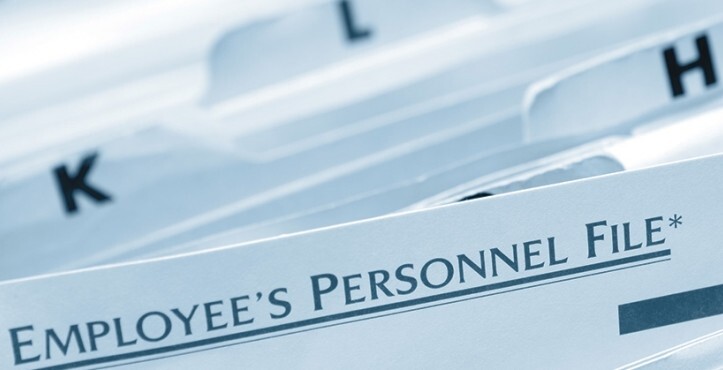Understanding Employee Personnel File Request Process
Personnel files are an essential component of any organization’s human resources department. These files contain important information about employees, such as their employment history, performance evaluations, disciplinary actions, and any other relevant documents.
Personnel files serve as a comprehensive record of an employee’s journey within a company, from the time they are hired until the time they leave or retire.
For employers, personnel files are crucial for maintaining accurate and up-to-date records of their employees. These files help employers make informed decisions about promotions, raises, and terminations.
They also serve as a legal record in case of any disputes or claims that may arise in the future. Personnel files provide employers with a complete picture of an employee’s professional journey and can be used as evidence in legal proceedings.
Crown’s HR management software can help employers and HR to facilitate this process.
Similarly, personnel files are also important for employees. These files contain valuable information that can be used to protect their rights and advance their careers. By accessing their personnel files, employees can ensure that the information contained within is accurate and up to date.
They can also use these files to track their progress, identify areas for improvement, and gather evidence of their achievements. Personnel files are a valuable resource for employees to have a clear understanding of their employment history and to advocate for themselves when necessary.
Importance of Personnel File Requests

Accessing personnel files through formal requests can provide numerous benefits for employees.
Firstly, it allows them to review the information contained within their file to ensure its accuracy.
Mistakes or inaccuracies in personnel files can have serious consequences for employees, such as being passed over for promotions or facing disciplinary actions based on incorrect information.
By reviewing their personnel file, employees can identify any errors and take steps to correct them.
Personnel file requests also allow employees to gather evidence of their achievements and contributions within the company. This information can be invaluable when seeking promotions or negotiating salary increases.
By having access to their personnel file, employees can compile a comprehensive record of their accomplishments and use it to demonstrate their value to the organization.
Furthermore, personnel file requests can help employees protect their rights.
By reviewing their file, employees can ensure that they are being treated fairly and in accordance with the law. They can identify any instances of discrimination, harassment, or other illegal practices and take appropriate action.
Personnel file requests empower employees to advocate for themselves and hold their employers accountable for any wrongdoing.
Understanding Legal Requirements for Personnel File Requests

In India, there are no specific legal requirements for employers to provide access to personnel files to employees. However, some states have laws that allow current and/or former employees access to the contents of their personnel files. Employers should be aware of the requirements in the state(s) where their employees work and define internal policies accordingly.
Additionally, employers must obtain written consent from employees before collecting their personal information, as per Rule 5(1).
Employers in India are required to retain employee personal data for a minimum of three years, as per the laws on limitation regarding civil legal proceedings.
Additionally, specific laws mandate the preservation of various employee records for different periods under acts like the Employees’ Provident Fund Act, the Employees’ State Insurance Act, and the Minimum Wages Act.
For instance, the Employees’ Provident Fund Organization requires records to be kept for five years from the date of the last entry, while the Minimum Wages Act mandates a retention period of three years after the last entry.
Moreover, documents related to employment or personnel information should be retained for at least 8 years in India.
Employers must adhere to these retention requirements to ensure compliance with Indian labor and employment laws.
Types of Personnel File Requests
There are several types of personnel file requests that employees may need to make throughout their employment journey.
The most common types include:
- access requests
- review requests
- correction requests
An access request is a formal request made by an employee to obtain a copy of their personnel file. This request allows the employee to have a physical or digital copy of their file for their own records.
Access requests are typically made when an employee wants to review their file in detail or gather evidence of their achievements.
A review request, on the other hand, is a request to review the contents of the personnel file in person. This type of request allows the employee to physically examine the documents in their file and take notes or make copies if necessary.
Review requests are often made when an employee wants to ensure the accuracy of the information in their file or gather evidence for a specific purpose, such as a promotion or legal claim.
Correction requests are made when an employee identifies errors or inaccuracies in their personnel file and wants to have them corrected. These requests typically require the employee to provide supporting documentation or evidence to substantiate their claim.
Correction requests are important for ensuring that an employee’s personnel file accurately reflects their employment history and performance.
Steps for Making a Personnel File Request
-

Study relevant laws
-

Determine the PIC
-

Prepare your request
-

Submit your request
-

Following up
Making a personnel file request requires careful attention to detail and adherence to specific procedures. Here are the steps employees should follow when making a personnel file request:
1. Familiarize yourself with the relevant laws: Before making a personnel file request, it is important to understand the laws and regulations that govern access and review rights in your jurisdiction. This will ensure that you are aware of your rights and can make an informed request.
2. Determine who to contact: Identify the appropriate person or department within your organization to submit your personnel file request. This is typically the human resources department or a designated individual responsible for managing personnel files.
3. Prepare your request: Clearly state your intention in making the request, whether it is for access, review, or correction purposes. Be specific about the documents or information you are seeking and provide any necessary details or context.
4. Submit your request: Follow the designated process for submitting your personnel file request. This may involve filling out a form, sending an email, or submitting a written letter. Be sure to include all required information and any supporting documentation if necessary.
5. Follow up on your request: After submitting your personnel file request, follow up with the appropriate person or department to ensure that it has been received and is being processed. Keep a record of all communication related to your request for future reference.
Common Mistakes to Avoid When Making a Personnel File Request
While making a personnel file request may seem straightforward, there are common mistakes that employees should avoid ensuring a successful request.
One common mistake is failing to familiarize oneself with the relevant laws and regulations. Each jurisdiction may have different requirements and procedures for personnel file requests, so it is important to understand the specific rules that apply to your situation. Failure to do so may result in delays or denials of your request.
Another mistake is not providing enough information or context in your request. It is important to clearly state the purpose of your request and provide any necessary details or supporting documentation. This will help the person processing your request understand your needs and locate the relevant documents more efficiently.
Additionally, failing to follow up on your request can also be a mistake. It is important to stay engaged in the process and ensure that your request is being processed promptly. Following up allows you to address any issues or concerns that may arise and ensures that you receive the information you need.
How Employers Respond to Personnel File Requests
Employers have a legal obligation to respond to personnel file requests on time. The specific response may vary depending on the jurisdiction and the nature of the request.
In some cases, employers may provide employees with a complete copy of their personnel file upon request. This can be in physical or digital form, depending on the employer’s record-keeping practices. Providing a complete copy of the file allows employees to review all the information contained within and ensure its accuracy.
In other cases, employers may require employees to review their personnel file in person under supervision. This ensures that the information in the file remains confidential and prevents unauthorized access or tampering. Employees may be allowed to take notes or make copies of specific documents during the review process.
In situations where employees identify errors or inaccuracies in their personnel file, employers are typically required to correct the information upon request.
This may involve providing supporting documentation or evidence to substantiate the claim. Employers should take prompt action to correct any errors and ensure that the employee’s personnel file accurately reflects their employment history and performance.
Make sure that employers have a personnel file checklist to stay organised.
Reviewing and Correcting Your Personnel File
Once an employee has gained access to their personnel file, it is important to review its contents thoroughly. This review allows employees to ensure that the information contained within is accurate and up-to-date.
When reviewing your personnel file, pay close attention to details such as employment dates, job titles, salary history, performance evaluations, and any disciplinary actions. Compare this information with your own records and raise any discrepancies or inaccuracies with your employer.
If you identify errors or inaccuracies in your personnel file, it is important to take steps to correct them. Start by gathering any supporting documentation or evidence that can substantiate your claim. This may include pay stubs, performance reviews, or emails that provide a different account of events.
Next, submit a formal correction request to your employer. Clearly state the errors or inaccuracies you have identified and provide the supporting documentation or evidence. Follow the designated process for submitting correction requests and keep a record of all communication related to your request.
Employers are typically required to take prompt action to correct any errors in an employee’s personnel file. This ensures that the file accurately reflects the employee’s employment history and performance. If your employer fails to address your correction request, you may need to seek legal advice or file a complaint with the appropriate regulatory agency.

Confidentiality and Security of Personnel Files
Confidentiality and security are paramount when it comes to personnel files. These files contain sensitive and personal information about employees, and it is the employer’s responsibility to protect this information from unauthorized access or disclosure.
Employers should have strict protocols in place to ensure the confidentiality and security of personnel files. This may include physical measures, such as storing files in locked cabinets or rooms, as well as digital measures, such as password-protected systems and restricted access to electronic files.
Employees should also be aware of their rights regarding the confidentiality and security of their personnel files. They have the right to expect that their personal information will be kept confidential and only accessed by authorized individuals for legitimate purposes.
If an employee suspects that their personnel file has been accessed or disclosed without authorization, they should report it to their employer immediately. Employers should take such reports seriously and conduct a thorough investigation to determine the cause and take appropriate action.
Here are some tips for managing employee personnel files in an effective way.
Maximizing the Benefits of Personnel File Requests
Personnel file requests are a valuable tool for employees to protect their rights and advance their careers. By accessing and reviewing their personnel files, employees can ensure that the information contained within is accurate and up to date. They can gather evidence of their achievements, track their progress, and advocate for themselves when necessary.
To make the most of personnel file requests, employees should familiarize themselves with the relevant laws and regulations in their jurisdiction. They should follow the proper procedures for making requests and provide all necessary information and documentation. By avoiding common mistakes and staying engaged in the process, employees can increase the likelihood of a successful request.
Employers have a legal obligation to respond to personnel file requests in a timely manner. They should provide employees with access to their personnel files and take prompt action to correct any errors or inaccuracies. Employers should also prioritize the confidentiality and security of personnel files to protect employees’ personal information.
In conclusion, personnel file requests are a powerful tool for employees to protect their rights and advance their careers.
By understanding the legal requirements, following the proper procedures, and staying engaged in the process, employees can maximize the benefits of personnel file requests and ensure that their employment history is accurately reflected in their personnel files.









